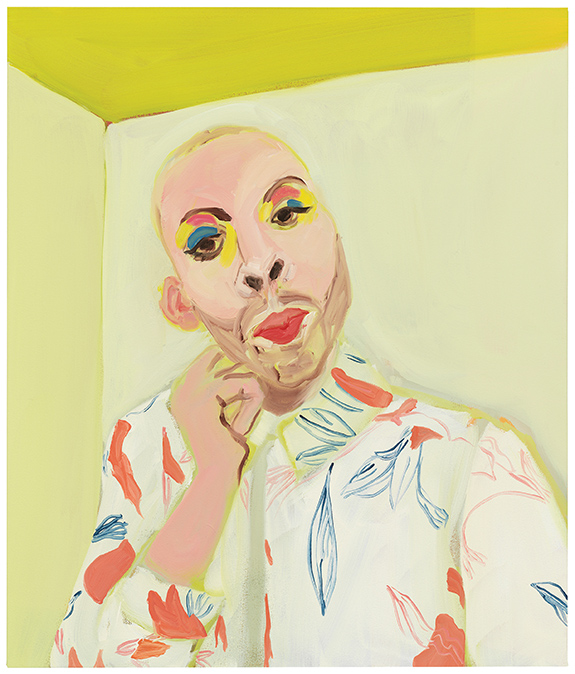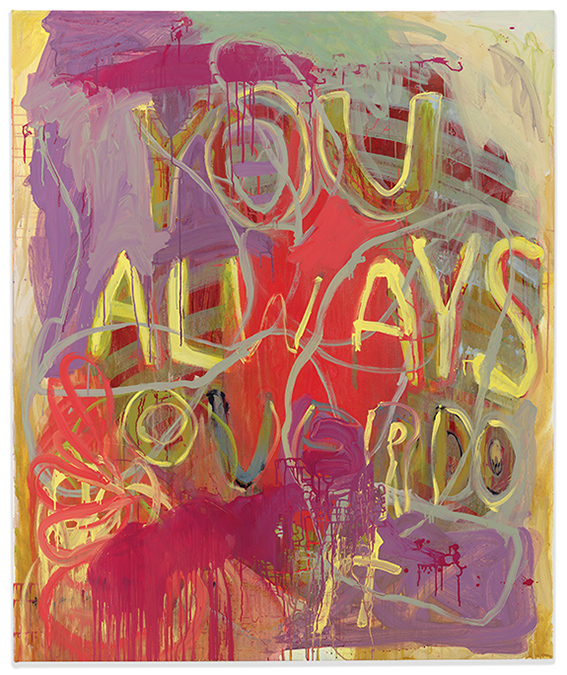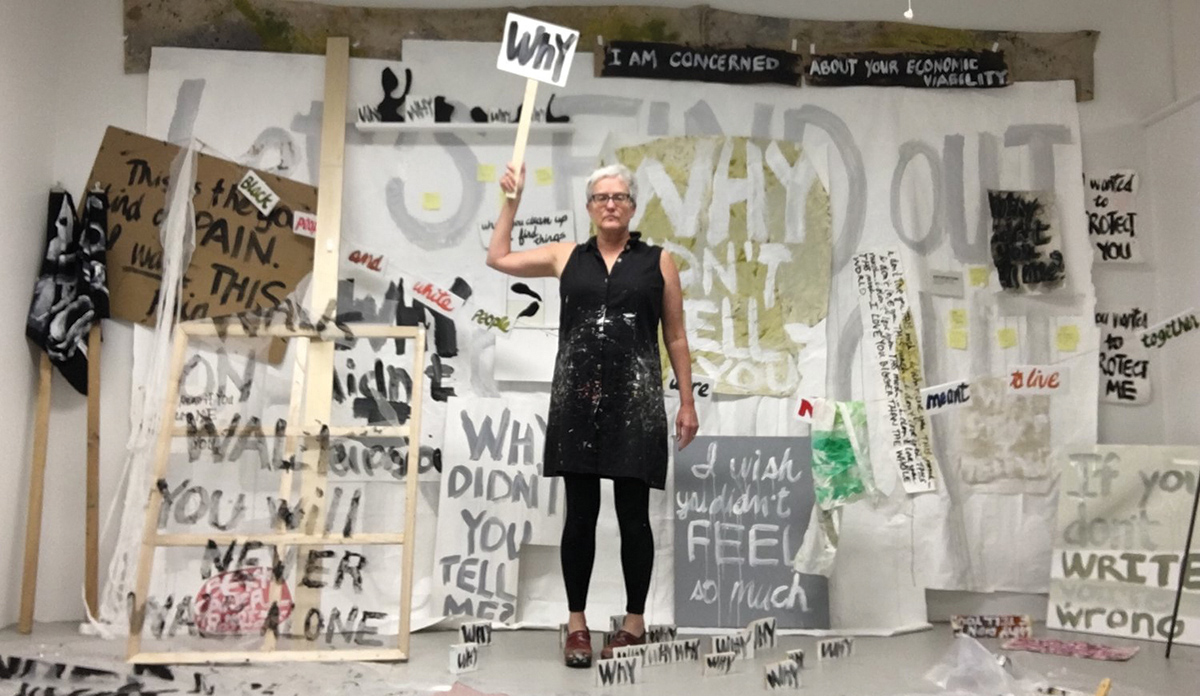Sisters Sisters
Nancy Murphy Spicer ’79 and Marianne Murphy Zarzana in Conversation
“Sisters, sisters / There were never such devoted sisters . . .” Who can ever forget that song of constant sisterhood sung by Rosemary Clooney and Vera-Ellen in the classic film White Christmas?
The spirit of that song certainly infuses this conversation between the Murphy sisters— Nancy Murphy Spicer ’79 (opposite page left) and Marianne Murphy Zarzana (ND ’78)—centered on Nancy’s rich career as a multidisciplinary artist and, more recently, as a Certified Professional Coach. Marianne is a force to be reckoned with as well. A poet and longtime professor of creative writing at Southwest Minnesota State University, she has retired to South Bend where she is working on a documentary film (Wild Irish Rose Productions) on Sister Jean Lenz, OSF, a pioneering woman leader instrumental in Notre Dame’s transition to a coed university.
MMZ: Describe the person at Saint Mary’s College who was most influential in your undergraduate experience and possibly beyond.
NMS: Definitely Sister Cecelia Ann Kelly! I studied drawing and painting with her, and even though my thesis exhibition was in fibers, I chose to work with her as my advisor. She was a caring yet tough professor who truly inspired us to stretch ourselves as artists. During the summer after graduation, Sister Kelly inspired me to volunteer for her program teaching religious education to young people in Chimayo, NM, a region known for excellence in traditional Spanish weaving. She introduced me to Jake Trujillo, one of the most gifted weavers, who offered me an apprenticeship. I spent the next five years living in northern New Mexico. A life-changing experience!
Here’s a famous quote:
Student: “ Sister Kelly, what should I paint?”
Sister Kelly: (throwing her arms up) “Oh, you young people! You just need to LIVE more . . . then you will know what to paint!”
Sister Kelly’s guidance helped me do just that!
Oh, you young people! You just need to LIVE more…then you will know what to paint!
- Sister Cecelia Ann Kelly
MMZ: After those five years in New Mexico, you packed up, drove cross-country to North Carolina, where you did an art residency at Penland School of Craft, then headed to Boston. Tell us about that pivotal experience at Penland and your next chapter as an artist and graphic designer in Boston.
NMS: In New Mexico, I taught sixth grade, designed and built solar greenhouses, started a graphic design business, and became a Quaker. I was learning about different ways to support myself and seeking clarity about the life I wanted to live and the kind of partner I yearned for. I missed making art. I drove across the US trying on different cities and landed at Penland School of Craft for two months studying ikat weaving, lithography, papermaking and letterpress printing. I was making art again embedded in a rich creative community.
A new friend at Penland offered to let me crash at her place in Cambridge, MA, and so began my 25 years in the Boston area. Shortly after arriving, my future husband walked into Cambridge Friends Meeting for Worship and sat down right next to me. We’ve been married for 36 years. In Boston (without the internet!), I started from scratch rebuilding my graphic design business and began taking art classes at the School of the Museum of Fine Arts Boston. I was deeply curious to see what I had to say as an artist at this time in my life.
MMZ: Your artwork has now been featured in exhibitions in galleries and museums in the US and in Europe: Boston, MA; Atlanta, GA; Chicago, IL; Berlin, Germany; London, UK; Bristol, UK; Richmond, VA; and Notre Dame, IN, at Saint Mary’s College. You’ve also created art installations and participatory works outside of the gallery. What has been most challenging and most gratifying about the process of creating art and then sharing your artwork with the public?
NMS: Most gratifying has been the opportunity to experience the entire arc from slimmest notion about a work I want to create to grappling with its emergence at every stage to feeling great doubts but continuing in spite of them to feeling a sense of rightness when a work comes together to receiving rigorous support from dear trusted colleagues to finding the best place for the work out in the world and finally letting go and getting to witness the impact that the work has on others.
The most challenging part has been to maintain an art practice over 25 years amid mothering, running businesses, four major moves (one international), 16 (yes, 16!?) different studios and 40 exhibitions. While the world yearns for art, our society does a very poor job of supporting artists. Almost every artist I know needs to have a day job or side gig that supports their art practice . . . so essentially having two professional lives. In my dream world, artists, musicians, writers, and performers are recognized for their very significant contributions to our culture, our lives, and can live with dignity and a sufficient income from their creative labor alone.
MMZ: To maintain your art practice amid all those challenges over the years, what tools and resources have you acquired, cultivated, and found most essential?
NMS: The most important resource has been my fellow artists and significant mentors. About 10 years after graduating from Saint Mary’s, I returned to school studying at the School of the Museum of Fine Arts Boston in their Diploma Program. There, I studied with artists who changed my entire understanding of what art could be: Deborah Boardman, David Kelley, Mags Harries, Marilyn Arsem, and many others. I also met many serious and talented artists, and the program allowed for completely unique plans of study. I explored performance, expanded notions of drawing, art history, and painting. I also connected with a community of artists. After school, I was continually encouraged to pursue my art by fellow artist and dear friend, Isa Mattei. I was invited to join with four other women artists, and we had studio visits every month for five years. It was an enormously supportive and functional group. I am sure that I would not be an artist today if not for those amazing women: Meg Alexander, Pat Shannon, Rebecca Doughty, and Beth Galston. All exceptionally talented artists. When I moved to England, I forged a lifelong artist friendship with artist and textile designer, Tessa Brown.
My time at SMFA liberated me to create a freewheeling and adventurous approach to artmaking. Initially, I used nontraditional materials to make unique works. House paint, electrical tape, cardboard, landscape cloth, and found objects. Working with performance artist Marilyn Arsem, I learned to see art not only as objects but also as space and the way the body performs in space.
Thus, studio space was very important for my practice. With each of the 16 studios I inhabited, my work was influenced by the architecture, the location, and the community in the building. They ranged in size from a part of my desk at home to a 1,000-square-foot warehouse space, a storefront, a shoreline community and, at the moment, my Covid studio in our dining room. And soon building will commence on a bespoke forever studio nestled in our garden in the backyard.
Also, here it’s important to give a shout-out to my beloved lifelong partner, David Eddy Spicer. He has always believed in me as an artist and supported my work. That took the form of numerous studio visits, helping me pack and move work, taking care of our daughters while I went away on residencies to make exhibitions, and never questioning the importance of my pursuit of my art in the midst of our very rich and complex family life.
MMZ: In mid-life, after being accepted by the School of the Art Institute of Chicago, you fully embraced the challenge of earning your MFA. How did that work build on your art studies at Saint Mary’s College and your other art studies? What would you say to women who are considering new professional challenges at mid-life?
NMS: When I was at Saint Mary’s, my questions were: “Am I an artist? And, if so, what KIND of artist do I want to be?” After studying drawing, painting, photography, and printmaking, I discovered the fibers studio, and that became my home. The requirement to have an exhibition in order to graduate galvanized my focus and was a very powerful moment in my life . . . to stand before my family, my colleagues, and my friends and say, “I AM an artist.”
Years later, while living in England, I deepened my love of teaching as an adjunct faculty member at the University of the West of England in Bristol, UK. In order to continue teaching when I returned to the US, I needed to get an MFA. After visiting all of the top Low Residency MFA programs on the East Coast and Chicago, I chose the School of the Art Institute of Chicago as my top choice. And, thankfully, they felt the same about me.
At SAIC, I pivoted away from the installations and more graphic work I had been doing and started painting. I was graced with brilliant professors: Dana DeGiulio, Molly Zuckerman-Hartung, Susanne Doremus, and Gregg Bordowitz. Painting was a return to the studies I had done with Sister Cecelia Ann Kelly at SMC. However, this time, I had a lot to say! The #MeToo movement was making headlines as I was deep into my research. My thesis painting exhibition was entitled The New Brag and featured portraits of women and queer folks standing in their power.

hidden and some yet to come.”) 2018, oil on canvas, 33" x 28"

As a professional life coach, I work primarily with women artists and entrepreneurs, many of whom are interested in reinventing themselves and returning to their art or finally giving it the time and focus it deserves. I encourage them to commit and be open to whatever work is trying to come through them. Make lots of “bad” stuff and don’t worry about it. This will be liberating! I tell them, “When you go into the studio, imagine you’re meeting up with your dearest friend. You show up completely as yourself. You don’t plan what you’re going to say. You just trust and flow with it. Do that with your art as well.”
MMZ: As a professional life coach, you’ve created a successful niche focused on women artists at all levels of their art careers. What motivates you to walk side by side with other women artists who are intent on taking their life and art journeys to a deeper level in spite of legitimately daunting obstacles, both internal and external?
NMS: My passion for working with creative women comes from my own personal struggles and my deep feminist perspective. In all my time in art institutions as a student and a professor, it was always the case that the classrooms are filled with predominantly female students. And then when I go out into the world to view art, it is still the case that male artists dominate the art world. So I see a strong need to support women artists and call them forth to do their work and be visible.
From my own experience, I learned a lot in the transition from living a vibrant art life in Boston to moving to England and having to essentially start over. It was a very challenging time in my life. Initially without a studio and art community, I felt unmoored and lost. It became clear to me that my art practice was essential for my overall mental health and sense of fulfillment in my life. As a coach, I want to support women to make the time and space and find the resolve to do the work they feel called to do.
MMZ: As a working artist and an art professor (at the School of the Art Institute of Chicago, University of the West of England, and Virginia Commonwealth University), what have you found most rewarding and most challenging about each of these two strands of your artistic vocation? Or to put it another way, how does your art practice feed your teaching vocation, and how does your teaching—and coaching—feed your art practice?
NMS: I feel energized every day as I work with so many powerful, determined, creative women! Both my students and my clients continue to create significant transformation in their practices and in their lives. As I teach and coach to inspire their best work, I can’t help but feel inspired by what they are able to create in their lives.
In the BUILD Your Studio Practice course I teach online, I take students through the arc of setting up a practice—from designing the studio to creating a canon of truly inspiring artists through to taking care of yourself and your art in the process and getting your work out into the world. I often revisit these lessons myself to enliven my own practice.
The Art Group is a smaller gathering of artists who have completed the BUILD course. They commit to bi-weekly gatherings over the course of a year. We have online studio visits to give each artist individual attention, critique and support. I learn a lot from the artists in this group. I can see as they get more deeply engaged in their practices, they get out into the world and see more work and the conversation just becomes richer and richer!
The most challenging aspect, as ever, is balance. As my coaching and teaching business grows, I need to continually balance the needs of my students and clients with my time actually running the business and also finding time to keep building my own work and practice.

MMZ: As the mother of two women who have also chosen to take artistic paths—Honora Spicer as a poet and translator of poetry and an academic, Anastatia Spicer as a weaver and a writer—can you recall a couple incidents, possibly humorous in retrospect, when your two young daughters may not have been exactly thrilled to have a mother who was a working artist? How did you deal with that?
NMS: As a young mother, I thought I could get more time in the studio if I brought the girls along. I quickly found that their curiosity could not be contained and they wouldn’t be satisfied just working with a select set of materials in a corner of the studio. From then onward, I was clear that the studio was my space alone.
But, as my mother did before me, I always had creative spaces and materials available for my girls at home. Making was always happening! There was a hand-knit teddy bear, a papier-mâché dolphin, elaborate Halloween costumes, thematic birthday cakes, handmade books, a mother-daughters drawing project, poetry reading/writing and much more.
One thing my daughters didn’t always enjoy was going to museums. I wanted to see art on a regular basis and, in order to do that, I often had to bring them along. I made a deal with them that every time we went to a museum, they got to pick out two postcards from the gift shop at the end. They loved it! And I was thrilled when I saw their bedroom walls with the postcards tacked up . . . having great works of art within view alongside their stuffed animals.
And, of course, now that my daughters are adults and very accomplished in their fields, I so appreciate the conversations we have around art, poetry, history, and material culture. I learn so very much from them!
MMZ: What question did I not ask that you would like the opportunity to reflect upon?
NMS: Well, I hope I have conveyed that life as an artist and a mother, coach and educator, is not easy and has involved a lot of twists and turns and accommodations. AND it is thoroughly worthwhile and enlivening. I have had to make a lot of sacrifices and work with the time, materials, and money that were available to me. I have found that constraints can be gifts as they provoke me to draw on my depth of determination and find new powers I didn’t know existed within me.

